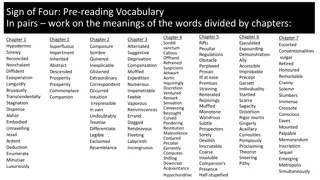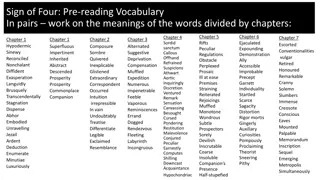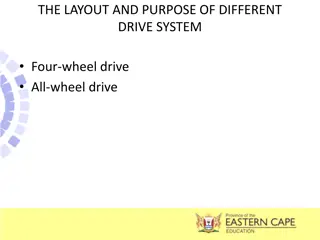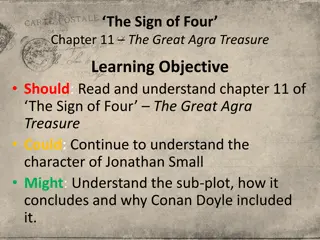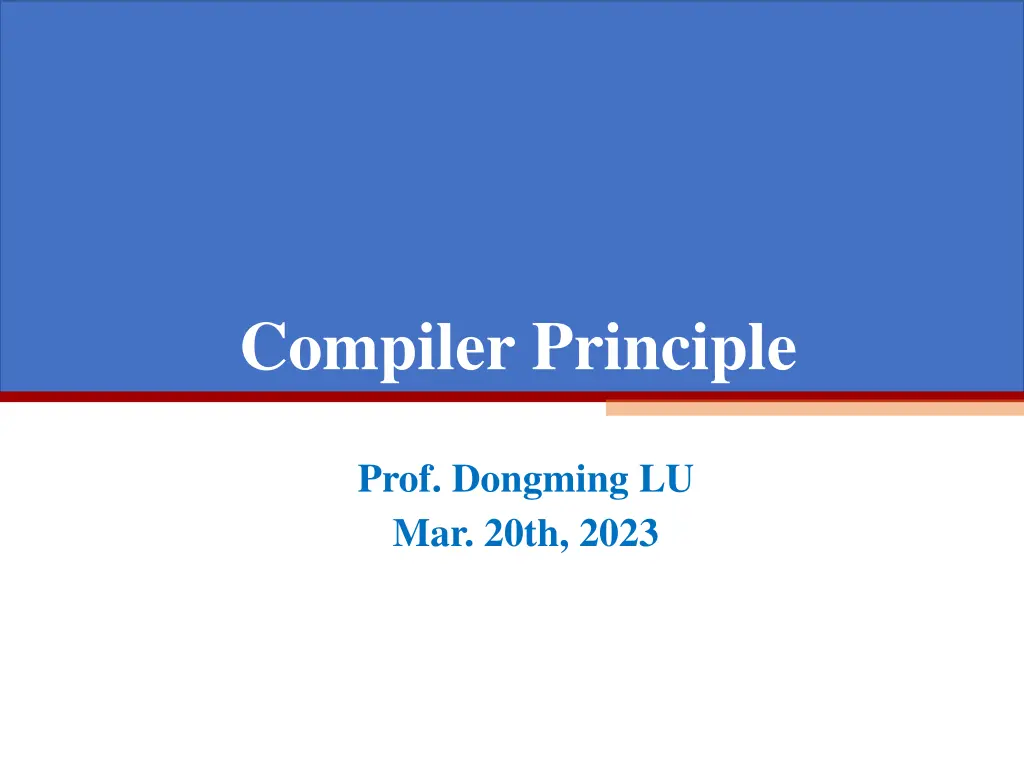
Compiler Principle with Prof. Dongming LU
Explore Compiler Principle with Prof. Dongming LU on Mar 20th, 2023. Learn about lexical analysis, parsing, abstract syntax, semantic actions, and more in the context of compiler design.
Download Presentation

Please find below an Image/Link to download the presentation.
The content on the website is provided AS IS for your information and personal use only. It may not be sold, licensed, or shared on other websites without obtaining consent from the author. If you encounter any issues during the download, it is possible that the publisher has removed the file from their server.
You are allowed to download the files provided on this website for personal or commercial use, subject to the condition that they are used lawfully. All files are the property of their respective owners.
The content on the website is provided AS IS for your information and personal use only. It may not be sold, licensed, or shared on other websites without obtaining consent from the author.
E N D
Presentation Transcript
Compiler Principle Prof. Dongming LU Mar. 20th, 2023
Content 1. INTRODUCTION 2. 3. 4. 5. LEXICAL ANALYSIS PARSING ABSTRACT SYNTAX SEMANTIC ANALYSIS 6. 7. ACTIVATION RECORD TRANSLATING INTO INTERMEDIATE CODE 8. OTHERS
4.1 SEMANTIC ACTIONS Do useful things with the phrase that parsed
Why Semantic Actions Each terminal and nonterminal may be associated with its own type of semantic value. A rule: A B C D The semantic action must return a value whose type is the one associated with the nonterminal A. It can build this value from the values associated with the matched terminals and nonterminals B, C, D.
Recursive descent S E $ E T E E + T E E T E E T F T T * F T T / F T T F id F num F (E) The semantic actions are the values returned by parsing functions, or the side effects of those functions, or both. T T * F The semantic action: int a = T(); eat(TIMES); int b=F(); return a*b;
Recursive descent int T_follow[ ] = { PLUS, RPAREN, EOF ,-1}; int T( void) {switch (tok) { case ID: case NUM: case LPAREN: return Tprime(F()); default: print("expected ID, NUM, or left-paren"); skipto(T_follow); return 0; }} int Tprime(int a) {switch (tok) { case TIMES: eat(TIMES); return Tprime(a*F()); case PLUS: case RPAREN: case EOF: return a; default: ... }}
Recursive descent int lookup(String id) { ... } int F_follow[ ] = { PLUS, TIMES, RPAREN, EOF ,-1}; int F(void ) {switch (tok) { case ID: {int i=lookup(tokval.id); advance(); return i; } case NUM:{ int i=tokval.num; advance(); return i; } case LPAREN: eat(LPAREN); {int i = E(); eatOrSkipTo(RPAREN, F_follow); return i; } case EOF: default: printf("expected ID, NUM, or left-paren"); skipto(F_follow); return 0; }} void eatOrSkipTo(int expected, int * stop) { if (tok == expected) eat(expected); else {print(...); skipto(stop); } }
Yacc-GENERATED PARSERS Whenever the generated parser reduces by a rule, it will execute the corresponding semantic action fragment. exp: exp + term {$$ = $1 + $3;} | exp - term | term ; {$$ = $1 - $3;} {$$ = $1;} term: term * factor {$$ = $1* $3;} | factor {$$ = $1;} ; factor :NUMBER {$$ = $1;} | ( exp ) {$$=$2;}
Yacc-GENERATED PARSERS A Yacc-generated parser implement semantic values by keeping a stack of the them parallel to the state stack. When the parser performs a reduction, it must execute a C-language semantic action. When the parser pops the top k elements from the symbol stack and pushes a nonterminal symbol , it also pops k from the semantic value stack and pushes the value obtained by executing the C semantic action .
4.2 ABSTRACT PARSE TREES To improve modularity, to separate issues of syntax from issues of semantics
A parse tree A data structure that later phases of the compiler can traverse. A parse tree has exactly one leaf for each token of the input and one internal node for each grammar rule reduced during the parse. A concrete parse tree Representing the concrete syntax of the source language An abstract syntax Conveys the phrase structure of the source program With all parsing issues resolved but without any semantic interpretation.
An abstract syntax It makes a clean interface between the parser and the later phrase of a compiler. The parser uses the concrete syntax to build a parse tree for the abstract syntax. The semantic analysis phase takes this abstract syntax tree.
An abstract syntax S S;S L S id:=E L LE S print L E id B + E num B - E E B E B * E S,E B / GRAMMAR 4.5 Abstract syntax of straight-line programs
%% prog: stm stm: stm SEMICOLON stm {$$=A_CompoundStm($1,$3);} Stm: ID ASSIGN exp {$$=A_AssignStm($1,$3);} Stm: PRINT LPAREN exps RPAREN {$$=A_PrintStm($3);} {$$=$1} exp: ID {$$=A_IdExp($1);} exp: INT {$$=A_NumExp($1);} exp: exp PLUS exp exp: stm COMMA exp {$$=A_OpExp($1,A_plus,$3);} {$$=A_EseqExp($1,$3);} exps: exp, exps exps : exp {$$=A_ExpList($1,$3);} {$$=A_ExpList($1,NULL);} Part of PROGRAM 4.6
In program 4.6 The Yacc parser: parsing the concrete syntax, constructs the abstract syntax tree. A_stm A_CompoundStm(A_stm stm1, A_stm stm2) { A_stm s= checked_malloc (sizeof (*s)); s->kind = A_CompoundStm; s->u.compound.stm1 = stm1; s->u.compound.stm2 = stm2; return s; }
A typedef for each nonterminal , a union-variant for each production. typedef struct A_stm_ *A_stm; struct A_stm_ { enum { A_compoundStm, A_assignStm, A_printStm} kind; union { struct {A_stm stm1,stm2;} compound; struct {string id; A_exp exp;} assign; struct {A_expList exps; } print; } u; }; A_stm A_CompoundStm (A_stm stm1, A_stm stm2);
POSITIONS If there is a type error that must be reported to the user, the current position of the lexical analyzer is a reasonable approximation of the source position of the error. In a one-pass compiler, the lexical analyzer keeps a "current position" global variable. A compiler that uses abstract-syntax-tree data structures need to remember positions accurately. pos fields indicate the position of the characters from which these abstract-syntax structures were derived.
POSITIONS When using Yacc, one solution is to define a nonterminal symbol pos whose semantic value is a source location (line number, or line number and position within line). %{ extern A_OpExp (A_exp,A_binop,A_exp,position); %} %union { int num; string id; position pos; .}; %type <pos> pos pos: { $$ = EM_tokpos; } exp: exp PLUS pos exp {$$= A_OpExp ($1, A_plus,$4,$3); }
Abstract syntax for Tiger /*absyn.h*/ A_var A_SimpleVar(A_pos pos, S_symbol sym); A_var A_FieldVar(A_pos pos, A_var var, S_symbol sym); A-var A_SubscriptVar(A_pos pos, A_var var, A_exp exp); A_exp A_VarExp(A_pos pos, A_var var); A_exp A_IntExp(A_pos pos, int i); A_exp A_OpExp(A_pos pos, A_oper oper, A_exp left, A_exp right); A_exp A_SeqExp(A_pos pos, A_expList seq); A_exp A_AssignExp(A_pos pos, A_var var, A_exp exp); A_expList A_ExpList(A_exp head, A_expList tail); Figure 4.7 Abstract syntax for the Tiger language
Abstract syntax for Tiger /*absyn.h*/ Typedef struct A_var_ *A_var Struct A_var_ { enum {A_simpleVar, A_fieldVar, A_subscriptVar} kind; A_pos pos; Union {S_symbol simple; struct {A_var var; S_symbol sym;} field; struct {A_var var; A_exp exp;} subscript; } u; }
Abstract syntax for Tiger The Tiger program a := 5; a+1 translates into abstract syntax as A_SeqExp(2, A_ExpList(A_AssignExp(4,A_SimpleVar(2,S_Symbol( a ),A_IntExp(7,5), A_ExpList(A_OpExp(11,A_plusOp,A_VarExp(A_SimpleVar(10, S_Symbol( a ))),A_IntExp(12,1))), NULL))) This is a sequence expression containing two expressions separate by a semicolon: an assignment expression and an operator expression. Within these are a variable expression and two integer constant expressions.






